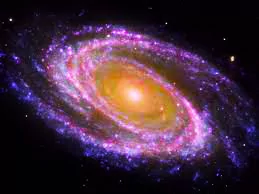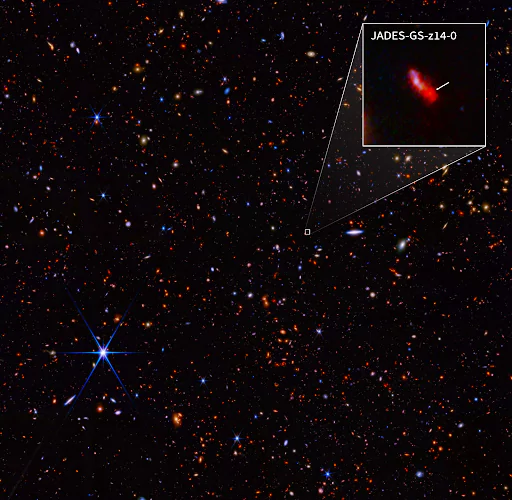NASA’s James Webb Space Telescope (JWST) has discovered the earliest-known galaxy which is unexpectedly bright and large for its age.
NASA’s James Webb Space Telescope (JWST) finds most distant known Galaxy JADES-GS-z14-0
They used JWST for observations as part of the JWST Advanced Deep Extragalactic Survey (JADES) program.
- JADES-GS-z14-0 was first seen using JWST’s NIRCam, a powerful camera that captures near-infrared light.
- NIRSpec: Confirmed extreme distance (high redshift).
- MIRI: Provided more details and confirmed vast distance.
Enroll now for UPSC Online Course
About Galaxy

It is a system of stars, stellar remnants, interstellar gas, dust, and dark matter bound by gravity.
Variety and Size
- Star Count: Average galaxy contains about 100 million stars.
- Size Range: From dwarf galaxies with less than a thousand stars to supergiant galaxies with up to one hundred trillion stars.
- Dark Matter: Most of a galaxy’s mass is dark matter; stars and nebulae make up only a small percentage.
- Central Features- Supermassive Black Holes: Commonly found at the centers of galaxies.
Classification
Galaxies are categorized by shape:
- Elliptical
- Spiral (e.g., Milky Way)
- Irregular
Check Out UPSC NCERT Textbooks From PW Store
Why is the galaxy so bright in the center?
The center of the galaxy is known as the Galactic Bulge
- It is the brightest due to the presence of more stars.
- In addition to the above, Stars within the galactic bulge orbit the centre in various planes.
|
About Galaxy JADES-GS-z14-0

- It is the most distant known galaxy from Earth.
- Formation: JADES-GS-z14-0 was formed approximately 290 million years after the Big Bang.
- Previously, the earliest-known galaxy was dated to 320 million years post-Big Bang.
Characteristics of Galaxy JADES-GS-z14-0
- Unique Properties: The galaxy contains young stars and significant ionized gas emission.
- Size: Measures about 1,700 light-years across.
- A light year is 9.5 trillion kilometers.
- Mass: Equivalent to 500 million stars the size of the Sun.
Findings of Galaxy JADES-GS-z14-0
- Strong ionized gas emissions: Researchers found evidence of strong ionized gas emissions (including hydrogen and oxygen) within the galaxy.
- The presence of oxygen suggests that multiple generations of massive stars had already lived their lives before observing the galaxy.
Enroll now for UPSC Online Classes
Significance of the discovery of Galaxy JADES-GS-z14-0
- Challenges previous Theories: This galaxy’s size and brightness don’t fit with existing ideas of how early galaxies formed.
- It suggests the process might be more surprising and complex.
- New Insights into Early Universe: Studying JADES-GS-z14-0 helps understand the formation and evolution of galaxies in the early universe.
- It provides insights into the conditions of the universe shortly after the Big Bang.
- Milestone in Cosmology: This discovery is a major breakthrough in our study of the universe’s early history.
Check Out UPSC CSE Books From PW Store
![]() 3 Jun 2024
3 Jun 2024


